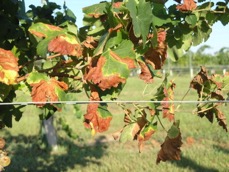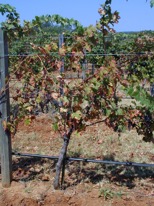COMMON NAME: Pierce’s Disease of Grapes

SCIENTIFIC NAME: Xylella fastidiosa subsp. fastidiosa
DISEASE DESCRIPTION
Pierce’s Disease (PD) of grapes, especially winegrapes, may be one of the most notorious of the 5 diseases in this series caused by X. fastidiosa subsp. fastidiosa. This disease is a serious problem for the rapidly expanding winegrape industry in Texas.
 SYMPTOMS:
SYMPTOMS:
Symptoms include marginal scorching where leaves develop yellow or red coloration along the margins in white and red varieties respectively. These leaves will dry up and fall off leaving behind the petiole and creating what is known as matchsticks. This is a specific symptom associated with Pierce’s Disease. During the growing season new canes will mature irregularly and produce “green islands”, these are areas of green tissue surrounded by mature brown bark. Eventually the grape clusters will become dry and shriveled on vines that are severely affected, known as raisining. Dieback and complete death of the entirety of the grapevines can also occur.
BIOLOGY:
Pierce’s Disease (PD) became widely established in Texas in the 1990’s due possibly to warmer temperatures in the winter. Caused by the bacterial pathogen Xylella fastidiosa, that lives in and affects the xylem of plant water-conduction system. This bacterium produces a plaque (gel-like) substance in the xylem as it grows called a biofilm, creating blockages and hindering the uptake of water. This disease is spread by insect vectors in the Cicadellidae (sharpshooter) and the Cercopidae (spittlebug) families, sucking insects that feed on the xylem of the grapevines. Symptoms of this disease can first be found on grapevines growing on the outer edge of the vineyard, spread to the interior of the field and appear mid – to – late summer when water stress occurs.
MANAGEMENT METHODS:
Managing Pierce’s disease can be done by the following:
- Treating vineyard and surrounding areas with insecticides for the insect vector
- Planting less susceptible varieties
- Removing canes or whole vines with PD symptoms
- Introducing parasitic wasps as a biological control
- Planting vegetation outside the vineyard that will not aid in carrying PD
RESOURCE LINKS*:
- https://aggie-horticulture.tamu.edu/fruit-nut/files/2010/10/Texas-Grape-Growers-PD-Management-Guide.pdf
- Pierce’s Disease Overview and Management Guide created by Texas Pierce’s Disease Research & Education and Texas A&M AgriLife. A resource for grape growers in Texas and other eastern U.S. growing regions
- http://ipm.ucanr.edu/PMG/r302101211.html
- University of California Agriculture & Natural Resources: Statewide integrated pest management program. Site focusing on the management of the insect vector of Pierce’s Disease and additional information on the sharpshooter insects.
- https://www.wineinstitute.org/initiatives/issuesandpolicy/piercesdisease
- Wine Institute initiatives on Pierce’s Disease with background in formation on the first steps of control and ongoing research and practices used in relation to California wine industry.
This factsheet is authored by Brittnay Meyer (Masters PLPM)
Factsheet information for the plant health issues represented by the images on the 2019 TPDDL calendar were written by graduate students enrolled in the Department of Plant Pathology & Microbiology PLPA601 Introductory Plant Pathology course in the 2018 Fall semester (course instructor: Dr. David Appel). This exercise provides an opportunity for a high impact learning activity where the students are tasked with producing an informational output directed to the general public and to provide opportunity for the students to write.
Photo credits: David Appel, Texas A&M University.